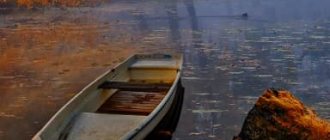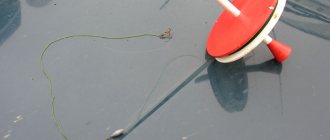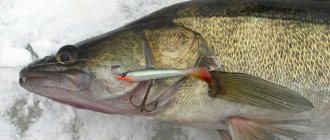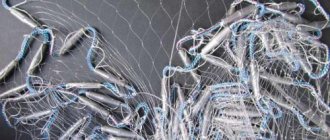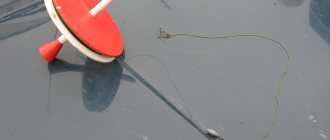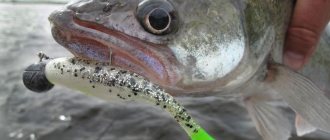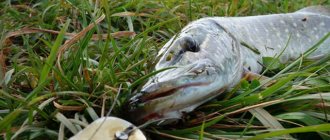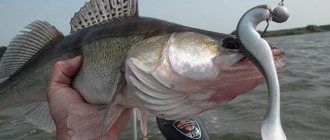Catching predatory fish, perch and pike with a wobbler and a spinner from a boat is a good solution for the fisherman; the catch will be guaranteed. Fishing involves the fisherman lowering a spoon into the water from a moving boat and catching fish.
Initially, fishermen called a track a special lure equipped with a single large hook. Many types of predatory fish have been successfully caught with it. The line is held on a reel (reel) or simply in the hands. The best option for this method of fishing would, of course, be a strong rod with guide rings, i.e. reel spinning. This tackle will allow you to abandon the old-fashioned reels and thick fishing line of 0.4 mm, allowing you to use ordinary braided wire with a thickness of 0.15-0.2 mm. When fishing as a pair, one angler will have to row the boat with oars, and the other will have to fish on the lane. If the fisherman is alone, then he should make sure that there is a special holder on the boat into which the butt of the spinning rod will be inserted. Attach the rod so as to ensure its angle with the surface of the water is 45-60 degrees. We install the reel on the brake.
Methods of fishing on the track
The track is a special device for catching predatory fish, which has several varieties.
- Catching by hand. The fisherman holds a loose line in his hand, and some even manage to hold it in their teeth, which is convenient when fishing alone. You can also press the cord with your foot or paddle.
- Fishing with a special reel.
- Fishing with a rod equipped with a reel. This is the best and more convenient equipment for the track, allowing you to maneuver a moving spoon and bring out fish stuck at depth.
Natural bait
In the following days, the dead “grass” pike turned into a real “racehorse”, despite the fact that it seemed too large for bait. True, the number of predators caught in absolute terms has noticeably decreased, but I have never again come across so many pike weighing over 10 kg.
In my opinion, it is best to explore unfamiliar bodies of water by “track” fishing, since it is easier to detect “hot spots” while moving. More or less promising places should be intensively fished during repeated loop-shaped passages.
Equipment for fishing on the track
Any rod equipped with guide rings is suitable for making a track: a reed rod with a thickened butt, 1 to 1.5 m long; rods for spinning fishing; from bamboo, hazel, young birch and other elastic wood. Usually the length of such a rod for the track is arbitrary, most often about 3 m. But longer ones can be used for fishing in thickets of bushes or reeds, when it is necessary to maneuver a moving spoon, circling it from one side or the other between the branches and shifting the rod from hand to hand .
Methods
There are several options for fishing this way. First of all, the differences lie in the supply of equipment. Most often, the bait is cast to about 25 meters, after which the line is slowly tightened. The second option is to smoothly immerse the equipment right next to the board, after which the fish are attracted exclusively by active play. In addition, it is worth considering the intensity of the current. In closed reservoirs, this factor can be ignored, since everything depends on the speed of the boat. With heavy currents, the game of the bait can change dramatically every minute.
Track fishing technique
The technique of catching pike on the track is quite simple, but it requires practical knowledge and skills in using tackle and operating a boat.
Fishing alone starts from a shallow, clean place, lowering the spoon to the bottom. They secure the rod in the boat or clamp it between their knees, gradually releasing the cord, and quietly move away from the shore. Having driven to the required distance, take the rod in your hand, lifting the spoon from the bottom with a slight sharp movement, and direct the boat upstream, adhering to the chosen course.
If you are going to use the spinning method, you can start right away, not from the shore. You need to row quietly, without making unnecessary splashes and noise, while the boat should move evenly, without jerking, then the spoon will remain at the same depth all the time, without rising or sinking unnecessarily. Based on fishing conditions, the length of the cord is adjustable from 20 to 80 meters. The shallower the location, the longer the length of the cord. If the fishing depth is 1.5-2 m, then the optimal cord length is from 40 to 60 m.
The spoon should not go along the bottom, but also not rise high. About half a meter from the bottom will be enough if it is relatively flat and clean. If the bottom of the reservoir is uneven, then it is better to cast the spoon at a distance of 1 meter from it or at “half water”. When the boat moves slowly, the spinner dives deeper, and when the boat moves faster, it rises higher. Therefore, in a fast current you need to row more slowly, and in a slow current - a little faster. The required speed is determined on site in a practical way.
How do you catch pike in winter?
As mentioned above, pike hunt almost all year round, with the exception of a two-week fast during spawning. With the onset of winter, it does not lose activity: experienced fishermen know what enviable specimens they take on the first ice not far from the shore - fishing is limited only by considerations of their own safety.
With the onset of deep winter, the predator shifts from the remains of coastal reeds towards wintering pits, where representatives of the carp family stand, representing the maximum gastronomic interest for it. During periods of sudden changes in weather, blizzards and strong winds, pike loses activity somewhat. At this time, you should make a choice in favor of delicate equipment and feeding the holes with mixtures with the addition of dry blood.
In clear sunny weather, even in severe frost, the pike begins to actively feed again, so you can return to traditional metal and Kevlar leashes. On the last ice, the bite intensifies even more: the predator prepares for spawning and feeds heavily, replenishing its energy reserves.
The most common winter gear is nodding fishing rods with artificial baits and live bait. In open water, you can use the winter variation of spinning.
Fishing rod
It is best to catch predators with a fishing rod during the periods of the first and last ice: in the dead of winter, this method of catching is not very productive. The baits used are usually vertical spinners and balancers. It must be taken into account that fishing is carried out vertically, and it is advisable to test all layers of water. Rattlins, which are bladeless balancers, are especially good for such initial reconnaissance. When fishing on the last ice, it is recommended to supplement the artificial bait with a worm or a piece of meat.
Universal rods are not suitable for pike fishing: a massive predator will instantly render a flimsy form unusable, so you should choose a reinforced version. A nod is used as a bite signal. If you are fishing with live bait, you can also use winter float equipment.
The productivity of fishing depends not only on the activity of the fish and the correct choice of place, but also on the skill of the fisherman. When vertical trolling is used, the bait is played directly near the bottom, with an amplitude of about 30 centimeters. An interesting option is a tube spoon: thanks to its design features, it not only moves vertically, but also slightly prowls in the water, further attracting the toothy hunter.
The balancer is played in a similar way, but it is also tapped on the bottom, varying the amplitude and periodically pausing. The predator usually attacks the bait on the rise. The more passive the pike, the softer and more delicate the game should be, but do not forget - we are dealing with a completely unpredictable fish.
It is advisable to drill several holes and fish them one by one, in the hope that the pike is loitering somewhere nearby. When searching for a site for this representative of the ichthyofauna, it is best to use an echo sounder, since visual identification of bottom anomalies under the ice is almost impossible.
Winter spinning
Experienced fishermen know that the activity of pike only intensifies with the onset of the first frosts. At this time, the ice is still unreliable, and huge areas of water remain completely open. Due to global warming, some rivers are not covered with a continuous layer of ice even in the dead of winter, so the use of spinning rods is quite possible.
The obvious advantage of this option is minimal competition and the absence of aquatic vegetation that complicates wiring. And among the disadvantages, first of all, it should be noted the discomfort for the fisherman (hands freeze very quickly) and the inaccessibility of many visually attractive places.
Winter equipment differs little from summer equipment, but there are still some nuances. Let's start with choosing a fishing rod - common carbon fiber does not withstand significant frosts. The second problem is with the coil: on some models the overrunning clutch simply does not work in such conditions, so it’s worth paying attention to other design solutions. It is definitely worth treating the elements with frost-resistant grease. The main fishing line is braided material of maximum density, preferably impregnated to protect against freezing.
In winter, pike are caught mainly with silicone baits and foam rubber, using the jig method. The greatest efficiency is demonstrated by classic steps, slow dragging along the bottom, and slow retrieves with hangs. The animation should be blurry, but quite expressive.
Zherlitsy
Before us is the most promising option for catching a toothy predator in the dead of winter, when other methods are ineffective. Winter vents, for the most part, have a more complex structure than summer ones.
Despite the abundance of design solutions, the most popular are “flags” that are installed directly on the hole, simultaneously protecting it from freezing. A vent of this type consists of a platform (usually disk-shaped), a stand with a coil attached to it (regular, inertial) and a flexible rod with a flag, usually orange or red. The equipment involves the use of live bait.
The process of charging the gear occurs as follows. Live bait is attached to the hook so that it is located at a distance of about 10-15 cm from the bottom. The line on the reel is fixed with a flag. When there is a bite, the line unwinds, the flag is released and flies up.
The greatest difficulty in this case is the need to drill a large number of holes. Typically, girders are installed in two rows with an interval of up to 10 meters along the shore. If the pike stubbornly does not want to be caught, they are moved away from the shore. Again, there is a need for an echo sounder and an ice auger with an electric or fuel engine. But if you have sufficient funds to purchase the appropriate equipment, this type of fishing will give you a lot of positive emotions.
Pike is a worthy opponent, a fight with which can fill your blood with adrenaline and your heart with the joy of victory over a strong and cunning predator. We wish you to get more luxurious trophies and promise to continue to delight you with useful publications!
Fishermen wonder why I’m biting and they’re not?
I’m revealing a secret just for you: it’s all about the miracle bait! More details
Rowing for pike perch
Track fishing on the August Reservoir is coming to an end. Every day, perch hunts more and more actively near the surface, attracting flocks of seagulls, and more and more confidently takes small jigs in the morning in familiar places. Pike perch, after rising from their nests at the beginning of summer and being well caught with jigs from the bottom for some time, then became a nocturnal predator. Oka spinning fishermen constantly talk about this, bringing back quite decent trophies, and then making fishermen friends with stories about night fishing. But is it only under the cover of darkness that pike perch come out to feed in the summer?
? As it turned out, this is not entirely true, one might even say not true at all! It is quite possible to catch pike perch, and good ones, even on a hot day, but to do this you need to move from the river to the reservoir. The difference seems to be small. At other times, yes, but now it is fundamental. At first, my friends and I, armed with a jig, spent several days in the morning and evening hours in vain tapping the most promising edges and underwater spits of the Yauzsky reservoir. More precisely, the result was still there, but not at all what we expected: only medium-sized zander and perch. But two months earlier, shortly after the end of the ban, good pike perch was perfectly caught from the depths in the same places. But he couldn’t go far, and since he’s not at the bottom, it means we need to look higher, we decided. And they were right.
The ban on trolling not only created certain inconveniences, but also brought its advantages to our fun, or rather oar fishing. But first things first. Most anglers who fish a lot in reservoirs and other low-flow bodies of water are well familiar with the phenomenon of a thermocline. Outside of shallow waters, water warms up only to a certain depth in summer, and there a sharp temperature drop occurs, called a thermocline. You can literally feel it on your own skin - just dive from a boat at some distance from the shore. The thickness of the heated layer can change as a result of mixing under the influence of strong winds or precipitation, but with the establishment of warm, windless weather, the depth of the thermocline is very quickly restored.
Small fish, which predators feed on, usually stay close to the border of warm and cold water and, as we established “by instruments,” wander in small schools throughout the entire reservoir, regardless of the features of the bottom topography. The forage fish is followed by a predator - usually pike perch, less often perch. Taking a worthy trophy in such conditions is a serious test of attentiveness, patience and clear knowledge of the operating parameters, especially the depth, of your pike perch wobblers. Not using an echo sounder for such fishing is about the same as catching carp or carp without bait. The echo sounder allows you to see both the prey of pike perch - small schooling fish, which look like small clouds on the screen, and the predator itself, which looks like separate large arcs. The depth where pike perch are held depends very much on the location of the food and to a much lesser extent on the topography. I often happened to catch pike perch in the upper layer of water above a depth of 10-15 meters, but it is better to start looking for it in an unfamiliar place from a horizon of 6-9 m, especially where the bottom topography is strongly pronounced or it is snagged.
The best rowing boat for the track that we were able to test turned out to be a factory-made plastic vessel - an impact craft for boat stations at the end of the last century. Both the echo sounder and the electric motor are easily mounted on the transom of this boat. You can sail on it under the oars without much strain and even with a certain comfort. When rowing with loose rigs, the baits move jerkily, which, of course, additionally provokes the predator to bite. It is better to make a release of 60-70 meters: the boat still scares the fish, especially when fishing at a depth of 2-2.5 m. A steel leash in this case is clearly superfluous, because catching pike in reservoirs near Moscow in the summer heat, and in addition to in the upper layers of water above a decent depth is an exceptional phenomenon. But it makes sense to walk along the fluorescent cord with a black marker, coloring a meter and a half in front of the bait. Fluorocarbon leashes, which have recently gained numerous supporters, are perhaps overkill, in any case, the number of bites with them does not noticeably increase.
The peculiarity of the track is that while it is desirable to tack when fishing with a motor, it is not necessary to do this with oars. Since there is no strong scaring noise, pike perch can take the bait directly from under the boat when reeling it in. And this happens quite often: for some reason the fish does not hit the bait, but pursues it, and only at the last moment does a decisive jerk and grab follow. This habit of pike perch is reminiscent of pike “shyness”, only the pike most often, having raised a breaker near the boat, leaves, and the pike perch, even noticing the fisherman, attacks to the end. There are often idle blows or pokes of the bait on the track. The pike perch can do this several times in a row with a short interval. In this case, it is possible to provoke a grip by changing the speed of movement from fast to slower or, conversely, increasing the tempo and strength of the strokes. Having risen to the surface, the pike perch very clearly adheres to a certain hunting horizon. Therefore, a difference in the depth of the bait of 50-60 cm can determine the outcome of the entire fishing trip. This means that the echo sounder readings should be taken much more seriously than when bottom fishing. More than once I have come across a situation where fishermen do not use additional settings on their echo sounders. For example, they turn off the function of intensifying the display of fish, because, supposedly, it is the bottom topography that is needed, not the fish. When fishing with a jig, this is acceptable, although it is also very controversial, but why deprive yourself of the opportunity to distinguish bream from pike perch or pike?
On the very first trips with the track, it unexpectedly turned out that pike perch can be very active near the surface throughout the day. and the peak bite occurs in the first three to four hours after noon. During this period, I found myself on short-term outings of 20-30 minutes, when the pike perch was taken as soon as I started rowing. Moreover, this was in the same places where before for an hour there had not been a single poke. As a rule, most of these periods of high activity occurred at sunny midday with a wave quite noticeable for a rowing boat. When choosing lures for fishing on the track, it is better to give preference to minnow wobblers with a mid-frequency action. For example, Magnet Minnow from Yo-Zuri and Bomber Long A are very good. You don’t have to be modest with the size: lures 8-10 cm long work great, and the largest pike perch were brought to me by 12-16 cm wobblers. Moreover, a large bait does not exclude the possibility of catching a pike-perch weighing only 800 g, but a larger predator usually still prefers the larger of the two wobblers following the boat at the same distance.
During sudden cold snaps, which also happen in the summer, near-surface fishing often fails, as the forage fish, and then the predator, go deeper by 2-3 m, which is immediately indicated by the echo sounder. But the biting time, oddly enough, does not change: the pike perch still takes it at noon only on deeper-water wobblers. Despite all the effectiveness of the track, it has one, but significant, in my opinion, drawback: the hunt for pike perch, regardless of the result, ends with calluses on the hands and cast-iron heaviness in the muscles.
Alexander Frolov, Gagarin, Smolensk region
